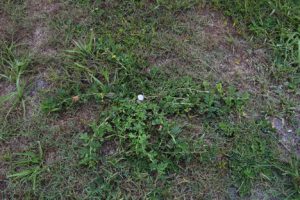Weed management is needed this time of year. Many Florida pastures are beginning to be invaded by weeds. Everyone would like to maximize forage production from pastures and hay fields while minimizing weed competition, within their budget. There are several factors to consider while trying to achieve this goal.
The overall health and management strategy of the pasture needs to first be assessed. Weeds are opportunistic. They take advantage of weak spots in pastures first and then may spread to other areas. The stronger and more competitive we can keep the desired forage, the more likely it is to out-compete weeds. Proper pH and plant nutrient levels in the soil are two important factors in achieving this. Grazing management is also very important in keeping an existing forage base strong. While some of our forage varieties are very durable and can tolerate close grazing, they tend to have stronger root systems when they have at least some rest during the growing season to restore their reserves.
Weeds are opportunistic.
The next step in weed management is basic weed identification. You do not need to know all the Latin names of a particular weed for this to be helpful. For example, is it a cool season or warm season weed? Is it a soft tissue broadleaf? A woody, brushy plant? An unwanted grass? While having an exact identification is best, being able to narrow it down is helpful too.
Mechanical control options like mowing or roller chopping can help to control some weeds, but can be inconsistent for other species. Herbicides are a good option for many weed problems, especially if the initial cost and long term effectiveness is superior to mechanical practices. If herbicides are going to be used, always carefully read and follow all label instructions.
For many soft tissued broadleaf weeds, 2,4-D offers good control at a reasonable price. It is the backbone of most pasture weed programs that has stood the test of time, being in continual use since the 1940’s. Dicamba is commercially blended with 2,4-D to broaden the spectrum of control and put a bit more bite in your application, but with more expense per acre.
For woody type weeds and brush, triclopyr is more effective than the compounds mentioned above. But if you have Tropical Soda Apple (TSA), aminopyralid either alone or mixed with 2,4-D is the best option. For smutgrass, hexazinone is a broadcast option and wiping or spot treatment with glyphosate can be effective. However, persistence is key to smutgrass control. After several years of seed drop, one application will rarely provide long-term control. Some of these products have multiple brand names. Take your reading glasses to read the fine print where the active ingredients are listed to make sure you are buying the product you want.
Timing is another key ingredient for successful weed control with herbicides. Actively growing weeds with good soil moisture are the easiest ones to control via chemical means. This gives you the opportunity to get a lot of product on the weed leaves so it can be piped down into the root system for long term control. Dry and/or cool weather can slow down weed growth and reduce herbicide effectiveness.
More information about weed management can be obtained by visiting this University of Florida publication or contacting your local UF-IFAS Extension Office.
If you have any pasture or livestock questions relating to Levy County please feel free to contact Ed Jennings, UF/IFAS Extension Director for Levy County at (352) 486-5131 or by email at edjennin@ufl.edu.
For information about Winter forage and Winter pastures and Warm season pastures
 0
0

